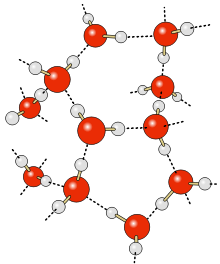In addition to “normal” water is also heavy water and super heavy water. In these waters, normal hydrogen atoms are replaced by deuterium and tritium isotopes. Heavy water has a physical nature (higher melting point, higher boiling point, higher specific gravity) and chemically different from normal water.
The composition and properties of water molecules
The water molecule consists of two hydrogen atoms and one oxygen atom. Geometrically, the water molecule has an angle of association of 104.45 °. Because the free electrons occupy more space, this angle is misaligned over the ideal angle of the tetrahedron. The length of the OH linkage is 96.84.

Bipolarity
Oxygen has a higher electronegativity than hydrogen. The triangular structure and the different electric charge of the atoms have led to positive polarity in the hydrogen atoms and the negative polarity in the oxygen atom, causing dipole. Based on two single electron pairs of oxygen atoms, the VSEPR theory explains the arrangement of the two hydrogen atoms, forming the dipole moment and hence the water’s unique properties. Since water molecules are electrically charged in different parts, certain types of electromagnetic waves, such as ultra-shortwave waves, can cause water molecules to oscillate, leading to heated water. This phenomenon is used to make a microwave oven.
Water molecules interact with each other through hydrogen bonding and thus have large molecular forces. This is not a sustainable link. The bonds of water molecules through hydrogen bonds only exist in a fraction of a second, then the water molecules separate from this bond and bind to other water molecules.

Water molecules
The small diameter of the hydrogen atom plays an important role in the formation of hydrogen bonds, because only hydrogen atoms can reach a sufficiently large amount of oxygen. Equivalents of water, such as hydrogen sulfide (H 2 S), do not form similar bonds because of the small charge difference between the bonds. The sequencing of water molecules through hydrogen linkage causes many of the water’s special properties, such as water, although a small molar mass of about 18 g / mol remains liquid in the water. standard package. In contrast, H 2 S gas exist in the same form in these conditions. Water has a specific weight of the largest At 4 degrees celcius and thanks to that the ice can float on the water; This phenomenon is explained by the hydrogen linkage.

Hydrogen bonding
The composition of the water molecule makes the hydrogen bonds between the molecules the basis for many properties of water. So far some of the properties of water are still a puzzle for researchers although water has long been studied.
The melting temperature and the boiling point of the water were used by Anders Celsius as the two landmarks for celcius. Specifically, the freezing point of water is 0 degrees Celsius, while the boiling point (760 mm Hg) is equal to 100 degrees celcius. Ice water is called ice . Steamed water is called steam . Water has a relatively high boiling point due to hydrogen bonding.
Under normal pressure, water has the highest density (density) at 4 ° C: 1 g / cm³, as water continues to expand as the temperature drops below 4 ° C. This is not observed in any other substance. This means: At temperatures above 4 ° C, water has the same properties as everything else: hot, cold, cold; But with temperatures below 4 ° C, the water is cold and warm. Due to the special shape of the water molecule (with a 104,45 ° bond angle), when cooled, the molecules must be removed to form an open hexagonal crystal. Therefore, the density of ice is lighter than liquid water. [first]

When frozen below 4 ° C, the water molecules must move away to form an open hexagonal crystal.
Water is a good solvent due to bipolarity. Polar or ionic compounds such as acid, alcohol and salt are readily soluble in water. Water solubility plays a very important role in biology because many biochemical reactions occur only in aqueous solutions.
Purified water does not conduct electricity. However, due to their good solubility, water or mixed impurities, usually salts, produce free ions in the aqueous solution allowing current to flow.
Chemically, water is an amphoteric substance that can react like an acid or base. At pH 7 (neutral) the content of hydroxide ions (OH – ) is balanced with the content of hydronium (H 3 O + ). When reacting with a stronger acid such as HCl, the water reacts like an alkali:
With ammonia water reacts like an acid:
Life on Earth originates in the country. All life on Earth depends on the water and the water cycle.
Water has a decisive influence on climate and is the cause of weather. Uneven heating of the oceans creates the ocean currents. The Gulf Stream transmits warm water from the Gulf of Mexico to the North Atlantic, affecting the climate of some parts of Europe.
Water is an important component of biological cells and is an environment of basic biochemical processes such as photosynthesis.
More than 70% of the Earth’s surface is covered by water. Water on Earth is about 1.38 billion km³. Of this 97.4% are saline water in the world’s oceans, the rest 2.6% are freshwater, mainly in the form of snow ice at the poles and mountains. 0.3% of the world’s water (or 3.6 million km³) can be used as drinking water. Drinking water will be one of the greatest challenges of humanity in the next few decades. Water also caused one of the Middle Eastern wars.
Water has been used in the industry for a long time as a fuel source (water mill, steam engine, hydroelectric plant), as a heat exchanger.
Empedocles Greek philosopher considered water to be one of the four sources of matter (besides fire, earth and air). Water is also in the Marble of Chinese philosophy.
With the increasing pollution and increasing population, clean water is expected to soon become a valuable resource no less than oil in the last century. But unlike oil, which can be replaced by other fuels such as electricity, biofuels, gas, water can not be replaced and all nations need it to secure it. As a result, the water issue has become an important topic in international conferences and water contradictions have been predicted in the future.
VINAPOOL by source (Wikipedia)